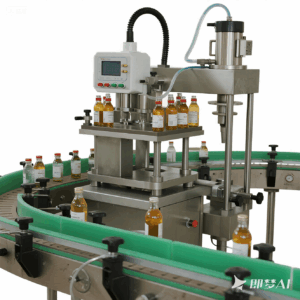Whether you produce beverages, sauces, cosmetics, or household cleaning products, the reliability of your bottle filling and capping machines processes directly impacts product quality and customer satisfaction.
One of the biggest decisions manufacturers face when selecting equipment is whether to invest in a manual or automatic filling and capping machine.
While both share the same basic purpose—precisely filling bottles and securing caps—they differ significantly in speed, cost, labor requirements, and suitability for different production scales. Understanding these differences can help you make a smart investment that aligns with your production goals.

Manual Bottle Filling and Capping Machine: Affordable but Labor-Intensive
Manual bottle filling and capping machinesare manually operated. Workers manually position the bottle, activate the filling nozzle, apply the cap, and tighten the cap using simple mechanical tools or a handheld capping machine. These machines are often favored by small businesses, startups, or niche manufacturers.
- Advantages: Low initial investment, ideal for companies with limited budgets. Flexibility: Quickly adjust to accommodate different bottle sizes or cap designs. Compact design: Fits into tight production spaces. Easy to train, requiring minimal technical expertise.
- Disadvantages: Low production output, typically only a few hundred bottles per hour. High labor requirements—multiple workers are required for sustained production.
For example, a local craft beverage brand producing 300 bottles per day might prefer a manual bottle filling and capping machine due to its low cost and ability to accommodate seasonal product variations.
Fully Automatic Bottle Filling and Capping Machine: High Speed and Precision
Fully automatic bottle filling and capping machines integrate conveyors, automatic cap sorters, cap placement, and a torque control system, completing most tasks without human intervention. Bottles flow seamlessly through the filling and capping stages, ensuring efficiency and consistency.
Advantages: High production rates, processing thousands of bottles per hour. Consistent quality, with automatic torque control ensuring uniform capping. Reduced labor requirements, allowing one or two operators to monitor the entire line. Easy integration, allowing for connection to labeling, packaging, and inspection systems.
Disadvantages: High initial investment, requiring substantial capital. Space requirements, requiring a larger footprint for installation. Technical expertise is required, along with well-trained operators and maintenance personnel.
For example, a national beverage company producing 20,000 bottles per day would benefit from an automated bottle filling and capping machine to minimize downtime and ensure consistent brand image.
Comparing Manual and Automatic Bottle Filling and Capping Machines
| Feature | Manual Bottle Filling and Capping Machines | Automatic Bottle Filling and Capping Machines |
| Speed | 200–500 bottles/hour | 1,000–10,000+ bottles/hour |
| Consistency | Operator-dependent | Highly uniform |
| Labor Needs | Multiple operators | Minimal staffing |
| Flexibility | Very high | Moderate |
| Initial Cost | Low | High |
| Maintenance | Simple | Requires skilled technicians |
Semi-automatic Bottle Filling and Capping Machine: A Scalable Solution
Semi-automatic bottle filling and capping machines combine manual control with mechanical assistance, making them a versatile choice for many production environments. The operator loads the bottles and caps, while the machine controls filling accuracy and applies consistent torque for capping.
This blend of manual handling and automated precision allows businesses to achieve higher quality output without fully relying on labor or committing to the higher costs of complete automation. This type of machine is popular with growing businesses that want to improve efficiency but don’t want to commit to the full cost of automation.
They can often be upgraded later by adding automatic bottle feeders or cap applicators, making them a wise choice for businesses planning expansion and seeking a smooth transition toward full automation in the future.
Maintaining Long-Term Bottle Filling and Capping Machine Performance
Clean the filling nozzle daily to prevent residue buildup that could affect filling accuracy or contaminate products. Lubricate mechanical components regularly to reduce friction and prevent premature wear. Check the torque setting to ensure a consistent seal and avoid leakage issues.
Replace worn or damaged parts promptly to prevent downtime and protect product quality. In addition, follow the manufacturer’s recommended maintenance schedule and keep spare parts in stock for quick replacement.
Training operators on proper cleaning and handling procedures will further extend the machine’s lifespan and ensure it runs smoothly for years, protecting your investment and supporting continuous production efficiency.
Conclusion:
When selecting the right bottle filling and capping machine, you should consider the following factors: Machine throughput: Match the machine’s capacity with your daily production output.
Bottle filling and capping machine product range: Prioritize flexibility if you frequently change bottle or cap types. Budget and return on investment: Weigh the upfront cost against the long-term labor cost savings. Available space: Ensure adequate space for installation and operation.
In order to plan for future growth, equipment that can accommodate higher production volumes should be selected.
